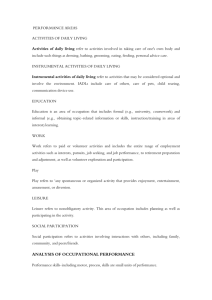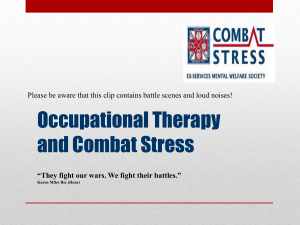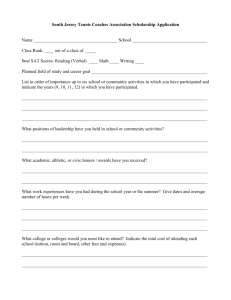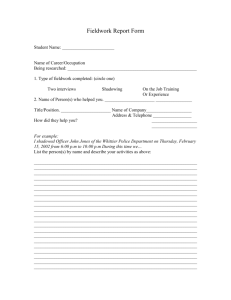Occupation, health and well-being
advertisement
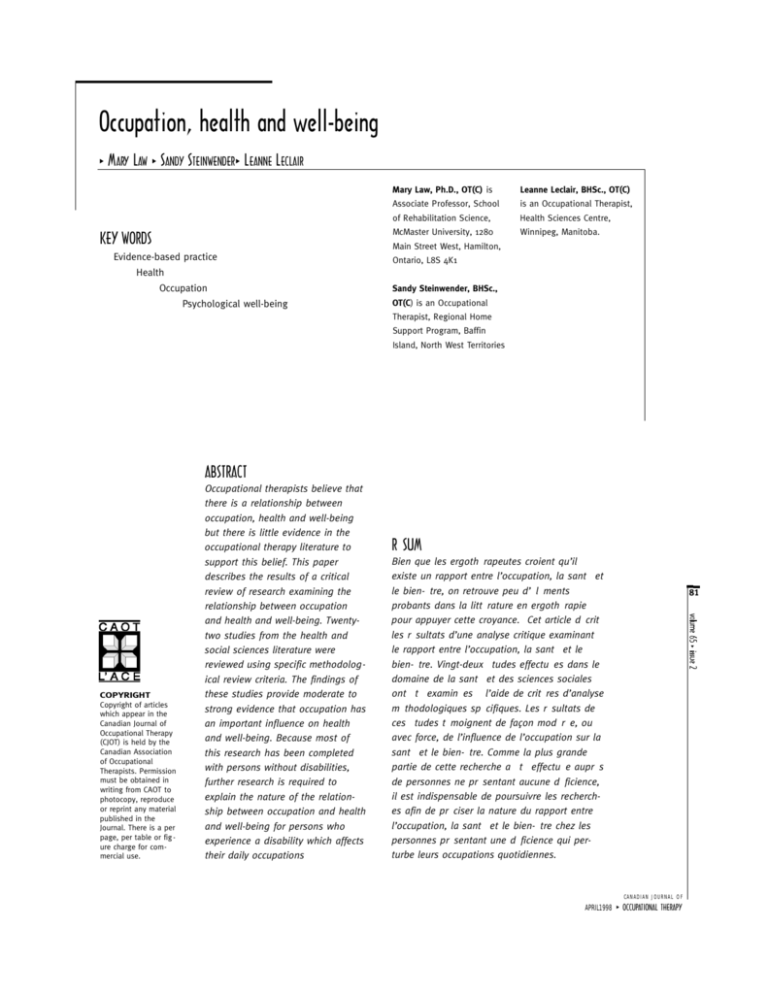
Occupation, health and well-being • M ARY LAW • SANDY STEINWENDER• L EANNE LECLAIR Mary Law, Ph.D., OT(C) is KEY WORDS Leanne Leclair, BHSc., OT(C) Associate Professor, School is an Occupational Therapist, of Rehabilitation Science, Health Sciences Centre, McMaster University, 1280 Winnipeg, Manitoba. Main Street West, Hamilton, Evidence-based practice Ontario, L8S 4K1 Health Occupation Psychological well-being Sandy Steinwender, BHSc., OT(C) is an Occupational Therapist, Regional Home Support Program, Baffin Island, North West Territories ABSTRACT COPYRIGHT Copyright of articles which appear in the Canadian Journal of Occupational Therapy (CJOT) is held by the Canadian Association of Occupational Therapists. Permission must be obtained in writing from CAOT to photocopy, reproduce or reprint any material published in the Journal. There is a per page, per table or fig ure charge for commercial use. Occupational therapists believe that there is a relationship between occupation, health and well-being but there is little evidence in the occupational therapy literature to support this belief. This paper describes the results of a critical review of research examining the relationship between occupation and health and well-being. Twentytwo studies from the health and social sciences literature were reviewed using specific methodological review criteria. The findings of these studies provide moderate to strong evidence that occupation has an important influence on health and well-being. Because most of this research has been completed with persons without disabilities, further research is required to explain the nature of the relationship between occupation and health and well-being for persons who experience a disability which affects their daily occupations RÉSUMÉ Bien que les ergothérapeutes croient qu’il existe un rapport entre l’occupation, la santé et le bien-être, on retrouve peu d’éléments probants dans la littérature en ergothérapie pour appuyer cette croyance. Cet article décrit les résultats d’une analyse critique examinant le rapport entre l’occupation, la santé et le bien-être. Vingt-deux études effectuées dans le domaine de la santé et des sciences sociales ont été examinées à l’aide de critères d’analyse méthodologiques spécifiques. Les résultats de ces études témoignent de façon modérée, ou avec force, de l’influence de l’occupation sur la santé et le bien-être. Comme la plus grande partie de cette recherche a été effectuée auprès de personnes ne présentant aucune déficience, il est indispensable de poursuivre les recherches afin de préciser la nature du rapport entre l’occupation, la santé et le bien-être chez les personnes présentant une déficience qui perturbe leurs occupations quotidiennes. 81 CANADIAN JOURNAL O F APRIL1998 • OCCUPATIONAL THERAPY Mary Law et al. s occupational therapists focus increasingly on health and function in the community, it is important for therapists to have approaches that are unique in community health and health promotion. The uniqueness of occupational therapy lies in its focus on occupation as central in promoting and maintaining health and well-being. One of the foundations underlying occupational therapy theory and practice is the belief that there is a relationship between occupation and health and well-being (Wilcock, 1993; Canadian Association of Occupational Therapists, 1997). The discipline of occupational therapy originated in the early 20th century as a means to use participation in daily occupations to restore the function and health of persons with mental illness and soldiers who were injured during World War I (Driver, 1968). The naming of the discipline of occupational therapy was based on observations that had been made about the relationship between occupation and health and well-being (Atwood, 1907; Barton, 1915; Hall, 1905). Although occupational therapists believe that participation in occupation enhances and improves health and wellbeing, there is little empirical evidence in the occupational therapy literature to support this belief. Research investigating these relationships is difficult because of the complex nature of occupation and lack of agreement about defining occupation, tasks and activities (American Occupational Therapy Association, 1995). The purpose of this paper is to describe a critical review of research examining the relationship between occupation and health and well-being. The specific issue that was investigated by the authors and forms the basis of this paper was the following: Is health and well-being determined by engagement in occupation? To address this issue, research in occupational therapy, other areas of health and social sciences was reviewed and critically analysed to explore the effect of occupation on health and well-being. A 82 Conceptual Framework A conceptual framework, the person-environment-occupation model, was used to guide the overall purpose of this project (Law et al., 1996). This framework emphasizes the relationship between several factors (personal, aspects of occupation, and environmental), and their effect on a person’s occupational performance and their health and well-being. Within a person, factors such as age, sex, socioeconomic status, genetics, self-efficacy and other performance components have an effect on occupational performance. As well, environmental factors, including social, physical, cultural and institutional characteristics, interact with personal factors to either facilitate or hinder the performance of roles and a person’s occupational performance. The third area which has an influence on occupational performance, health and well-being is that of occupation, the tasks and activities that persons perform on a daily basis. The relationship between persons, occupation and the environ- The Critical Review Process Before completing a review of the health and social sciences literature about the effect of occupation on health and wellbeing, it was important to use well-accepted definitions of the concepts of occupation, health and well-being. Therefore, the first stage of the review was to examine the literature to identify definitions and concepts about occupation, health and well-being which would be used to guide the literature review. Initially, articles in the occupational therapy literature and occupational therapy textbooks were analyzed to identify key concepts and definitions of occupation (Christiansen & Baum, 1991; McColl, Law & Stewart, 1993). Literature in the health and social sciences was also reviewed to explore varying definitions of health and well-being (Orem, 1980, 1985; Pander, 1982). The second stage of the review process focussed on identifying and selecting studies which addressed the effect of occupation on health and well-being. The following databases were included in the search strategy: Medline, Psychological literature, Sociofile, CINAHL, General Social Sciences Index, Humanities Index, and United States and Canadian government publications. The initial search strategy used the following terms: health, occupation, work, leisure, play, quality of health, self-care, physical activity, health status, personal care, volunteers, activity, activities of daily living, well-being, locus of control, and self-efficacy. The search was limited to articles published between 1980 and 1996 in the English language and involving humans. Research studies could include any population, both people with and without disabilities and focus on any setting, ranging from institutions to the community. From the studies that were identified using these criteria, the search was expanded to include research which was listed in the bibliographies of identified articles and government publications. All research studies found in the literature search were reviewed to ensure that they met all of the following criteria: (1) The focus of the study included self-care, productivity and leisure occupations, not simply one of these categories; (2) outcomes in the study centred on health and well-being as defined for this paper, rather than components of health and well-being; and (3) the article described a research study, not © CAOT PUBLICATIONS ACE LAREVUECANADIENNE D’ERGOTHÉRAPIE ment is not linear but a dynamic, constantly interacting relationship that influences the way in which persons perform daily tasks and activities. This performance, in turn, is believed to influence health and well-being. While recognizing that there is an interactive relationship between person, occupation and environment, the focus of the review described in this paper centres on the effect of one of these factors, occupation on health and well-being. Personal and environmental factors were not the primary focus of this critical review, but were analyzed related to how they mediate the effect of occupation on health and well-being. • AVRIL1998 Mary Law et al. simply a case example description. Research that focussed on the inclusion of purpose and meaning in specific tasks in experimental situations (Nelson et al., 1996) was not included because the tasks involved did not reflect the broad experience of participation in daily occupations. Research that examined specific relationships between self-care, work or leisure and health and well-being were also identified but will be reported in a later publication. In total, 23 articles focussing on the relationship between occupation and health and wellbeing were critically reviewed. Critical review forms for both qualitative and quantitative methods were developed. For studies using qualitative methods, criteria developed by Cobb and Hagermaster (1987), Forchuk and Roberts (1993), and Sandalowski (1986) were used to develop a review form that focussed on research purpose, the use of the researcher as instrument, sampling, dependability, triangulation and design flexibility. Information from Sackett, Haynes, Tugwell and Guyatt (1991), and Law (1987) were used to develop review criteria for research using quantitative methods. The review criteria for quantitative methods focussed on issues of design, sampling, generalizability, reliability and validity of measurement methods, and the statistical and clinical significance of the research findings. In order to ensure consistent application of the review criteria, the authors discussed the criteria in detail to ensure that there was a common understanding of criterion definitions. Four research studies were reviewed in detail by all authors to ensure consistency in the way in which the critical review was conducted. Each research study was then critically reviewed by one of the authors and this appraisal was evaluated by another author. Any discrepancies were discussed and a consensus was reached. The use of a common review form with explicit criteria, the development of a standard approach to the review, and the review of all studies by at least two authors ensured that the critical appraisal methods were applied consistently. Findings Definitions Occupation Conceptual and practice papers discussing occupation have centred on the complex nature of this term and the difficulty in arriving at consensus for a definition (AOTA, 1995). Occupation is often confused with other terms such as task, activity, function, and performance (AOTA, 1995; Christiansen & Baum, 1991). A common concept in all definitions of occupation is that occupation involves participation in different areas of daily living, that is, self-care, productivity and leisure. A position paper on occupation by the American Occupational Therapy Association (1995) stated that “occupation has been used to refer to an individual’s act of participation and selfmaintenance, work, leisure and play” (p. 1015). For the pur- poses of this paper, occupation was defined as “groups of activities and tasks of everyday life, named, organized and given value and meaning by individuals and a culture. Occupation is everything people do to occupy themselves, including looking after themselves (self-care), enjoying life (leisure), and contributing to the social and economic fabric of their communities (productivity)” (CAOT, 1997, p. 34). Health The literature about definitions of health includes many different definitions and ways of measuring health, ranging from those which emphasize objective measures to definitions which are broader and emphasize measurement by self-perception. Over this century, definitions of health have evolved from an initial emphasis on disease and mortality to the more recent consideration of health as a resource and part of everyday life (Epp, 1986). Health can be defined in a narrow way to indicate a bodily or mental functioning. Alternatively, it can be defined broadly, emphasizing health as personal fulfilment, an adaptive response, a capacity to perform to the best of a person’s ability, flexibility in encountering the challenges of life and an integrated functioning (Hartweg, 1990; Pander, 1982). The definition used for this review is from The Ottawa Charter (Epp, 1986) which stated, “health is created and lived by people in the setting of their everyday life, where they learn, work, play, and love. Health is created by caring for oneself and others, by being able to take decisions and have control over one’s life circumstances, and by ensuring that the society that one lives in creates conditions that allow the attainment of health by all its members”. Health is a positive concept, emphasizing social and personal resources, as well as physical capacity. 83 Well-Being Orem (1985) has emphasized well-being as a term that is used to describe an individual’s perception of their condition. Wellbeing refers to the integration of a person’s physical, mental, emotional, spiritual and social characteristics. Authors have emphasized well-being is an internal construct which may be independent of external conditions (Hartweg, 1990; Orem, 1985). For example, it is possible to be ill or not healthy and still have a sense of well-being. For the purposes of this review, well-being has been defined as an internal construct made up of reflective and spontaneous dimensions. Well-being is a perceived state of harmony in all aspects of one’s life. It is a state characterized by experiences of contentment, pleasure, by spiritual experiences, and a sense of happiness (Orem, 1985). The Effect of Occupation on Health and Well-being Twenty-three studies that examined daily occupations (i.e., self-care, productivity and leisure together) and their relationship with health and well-being were critically reviewed. It © CAOT PUBLICATIONS ACE CANADIAN JOURNAL O F APRIL1998 • OCCUPATIONAL THERAPY Mary Law et al. 84 became clear from the literature search that research addressed diverse aspects of the effect of occupation on health and well-being. Three types of research studies were identified. First, there was research that examined occupation as a part of life. In general, these studies were longitudinal or cross-sectional in design and described the natural history of people as they participate in various occupations during their lifetime. In these studies, there was no attempt to change or alter occupation, but rather the purpose was to study the naturally-occurring relationship between aspects of daily life participation and outcomes related to health and well-being. The focus of much of this research was on factors influencing health and well-being, of which occupation was one factor. The second group of studies examined situations, whether experimental or natural, where occupation had changed over a period of time. Some research, such as those evaluating the effects of occupational therapy intervention, examined the addition of occupation and its effect on health and well-being. Research also studied the withdrawal of occupation, most often through naturally occurring circumstances. A third group of research examined the influence of other personal and environmental factors on health and well-being. The specific focus of these studies was on factors which mediated the relationship between occupation, health and well-being. Information on the specific focus of each study, conclusions and important methodological issues uncovered during the review are summarized in Table 1. Findings about the effect of occupation on health show that the removal of occupation leads to increased stress, physiological changes and decreased health. Lokk et al. (1993) conducted a before and after study of 24 long-term attenders of a geriatric daycare unit, which was temporarily closed down, and reopened 7 weeks later. Plasma prolactin and cortisol levels, indicators of stress, were measured. It was found that the closing of the daycare unit led to increased levels of plasma prolactin and cortisol. The reopening of the daycare unit led to significantly decreased cortisol levels, while plasma prolactin continued to be higher. The authors conclude that the closing had a more pronounced effect than expected on participants’ stress levels, and the stress, as measured by blood plasma variables, did not totally disappear 7 weeks after reopening. Widerlov et al. (1989) conducted an experimental study to determine the impact of a programme to promote mental and physical integrity for residents with dementia during a threemonth period as compared to regular ward care. The experimental programme included a staff training component and focussed on increasing emotional and intellectual communication and physical activation on the ward. The study measured somatostatin concentrations in cerebral spinal fluid, as well as motor and intellectual functioning. Decreased somatostatin has been found to be associated with neurological and psychological illness. Elevated somatostatin levels in the cerebral spinal © CAOT PUBLICATIONS ACE LAREVUECANADIENNE D’ERGOTHÉRAPIE fluid concentration and significant improvements in cognitive and motor functions were demonstrated after 3 months by the group receiving the integrity promoting care. Qualitative studies contribute to our knowledge about the influence of the withdrawal of usual occupations through disease. Jongbloed (1994), in an ethnographic study of one person’s experiences after a stroke, found that the performance of occupations was disrupted and was influenced more by the physical and social environment than the person’s residual skills. A meta-analysis of qualitative studies of disease and its influence on health and well-being indicates that persons with disabilities were able to “reframe one’s place in the world” through participation in everyday activities (Jensen & Allen, 1994, p.353). Longitudinal studies of factors influencing health and well-being provide some of the most compelling support for the influence of occupation on health and well-being. Harris et al (1992) studied a cohort of 1,448 to explore differences in people above and below 65 years of age regarding the relationship between life satisfaction and health. Findings for both groups indicate that environmental influences (which in this study include activity participation) have a substantial influence on perceived health. Another study by Osberg et al (1987) examined quality of life amongst 97 persons discharged previously from rehabilitation centres. Age, functional capacity and participation in household and community activities were significant predictors of self-reported quality of life. Several studies with persons with spinal cord injuries reveal the significant relationship between maintenance of daily activities, social activities, community mobility and life satisfaction. Carpenter (1994), Yerxa and Baum (1986), Yerxa and Locker (1989), Fuhrer (1992) and McDonald et al. (1987) examined activity patterns, depression, perceptions of living and life satisfaction. Persons with spinal cord injury participated in the same activities as persons without a disability but spent significantly less time in work occupations and had more free time (Yerxa & Baum, 1986; Yerxa & Locker, 1989). Results also indicate that persons with spinal cord injury can achieve significant levels of life satisfaction and overall good ratings of health as compared to individuals who do not have a disability. There was a significant relationship between overall satisfaction and well-being, and satisfaction in home management and societal and community management. In the study by McDonald et al. (1987), decreased activity participation was associated with increased depression. Carpenter (1994), using qualitative interviews with 10 persons, found that as persons with spinal cord injury become more confident in their abilities, they were able to pursue occupational choices and this involvement leads to improved life satisfaction. • AVRIL1998 Mary Law et al. Table 1 Occupation, health and well-being Author/ Purpose Design Research Focus Outcomes/Methodological Issues Bach et al. (1995) To determine whether reactivating OT in addition to functional rehabilitation is more efficient than functional rehabilitation alone Randomized Controlled Trial N= 22 Addition of occupation The effect of OT intervention lead to increased cognitive and psychosocial function, increased autonomy in physical function and prevented secondary cause of illness. (OT Intervention-OT reactivation therapy 2X/wk @ 24 weeks to increase capacity for decision making and control in performing daily activities). Groups were similar on demographic variables. Reliability and validity of the outcome measures were not stated. Baum (1995) To explore the relationship between occupation and continued task performance and behavioural difficulties Cross-sectional N=72 Withdrawal of occupation Persons with Alzheimer’s disease who maintain involvement in daily occupation demonstrate less behavioural difficulties and require less assistance with self-care activities. The use of structured equation modelling strengthens the conclusion that can be made from cross-sectional data. Further longitudinal research about the ability of occupation to prevent deterioration is required. Boyle & Counts (1988) Exploration of healthy aging perceptions in older adults Qualitative N= 105 Occupation as a part of life Ability to work, take care on one’s self, exercise, nutrition and having a safe and supportive environment are perceived as most important factors in maintaining health. Large sample size and thorough analysis increases the dependability of the findings Carlson et al (1995) Meta-analysis of effectiveness of occupation therapy for older persons 15 studiesRCT, cohort, before-after, single subject Addition of occupation Mean effect size of .54 for occupational therapy intervention (success rate of 63% versus 37%). Because a variety of study designs were included in the meta-analysis, all studies may not have the same methodological rigour. Carpenter (1994) To explore perceptions of living with spinal cord injury Qualitative N=10 Withdrawal of occupation Describes initial experiential split between internal and external body and spirit. Rediscovery of self led to increased confidence to pursue occupational choices, adopt old interests getting involved and this led to life satisfaction. Thorough analysis of the experiences of person with spinal cord injury. Small sample size may limit the applicability of the results. Carson (1993) To investigate relationships b/w survival with HIV/AIDS and health promoting and spiritual activities Cross-sectional N= 100 Addition of occupation Positive relationship between participation in prayer and meditation, exercise and nutrition and perceived health and wellbeing. The use of a cross-sectional design limits the ability to make inferences about the exact relationships between occupation and health and well-being in the study participants. Clark et al. (1997) To evaluate the effectiveness of preventive occupational therapy for multi-ethnic older adults living independently in the community. Randomized controlled trial N=361 Addition of occupation Persons receiving a nine-month occupational therapy programme focused on health through occupation (2 hours per week in group programme plus 9 hours of individual occupational therapy) were compared to persons receiving a group activity (social) programme and a non-treated control group. Persons receiving occupational therapy improved significantly in quality (continued) © CAOT PUBLICATIONS ACE CANADIAN JOURNAL O F APRIL1998 • OCCUPATIONAL THERAPY 85 Mary Law et al. Table 1. Occupation, health and well-being (continued…) Author/ Purpose Design Research Focus Clark et al. (1997), con’t … Outcomes/Methodological Issues of interactions, life satisfaction, health perception, physical functioning, role limitations, vitality, social functioning and general mental health. Large, well-controlled study using reliable and valid measures. Measurement was completed by research assistants who did not know group assignment or the main purpose of the study. Follow-up assessments were completed on over 80% of randomized participants, and there were no significant baseline differences between persons completing the study and those not completing the study. Csikszentmihalyi & LeFevre (1989) To investigate quality of experience in everyday life Longitudinal N=78 Occupation as a part of life People experience much life satisfaction from work activities, even though they have increased motivation for leisure activities. This research does not directly address the relationship between occupation and well-being. Sample included more skilled workers. 44% of those approached agreed to participate. Further longitudinal research to examine satisfaction over time in work and leisure is needed. Fuhrer et al (1992) To describe life satisfaction of persons with spinal cord injury living in community Cross-sectional N= 140 Withdrawal of occupation There is a significant relationship between social support, community mobility, work and life satisfaction. Relationships between impairment, disability, and life satisfaction are not significant. Random selection of sample and use of standardized measures increases the generalizability of the study results. Hachey & Mercier (1993) The contribution of rehabilitation services to quality of life in psychiatric patients. Longitudinal N=152 Addition of occupation Positive but modest relationship (low) between occupation and quality of life and self perceived health not affected by use of rehabilitation services. Sample may not have been representative of persons with mental illness. Use of regression analysis may have provided a better indication about the inter-relationships between the variables measured in the study. Harris et al (1992) To explore age differences in the relationship between life satisfaction and self-rated health. Cross-sectional N = 1448 Occupation as part of life Genes and environment contribute to the relationship between life satisfaction (including participation in occupation) and self-rated health in both age groups of twins (<65 yrs & >65 yrs). In both age groups environmental effects mediate over half of the observed correlation between life satisfaction and health. Large study using reliable and valid measures. Aspects of occupation were measured as part of life satisfaction and not directly, so this limits the strength of conclusions that can be made from these data. Jensen & Allen (1994) Meta-analysis of qualitative studies on disease, health & wellbeing Qualitative Withdrawal of occupation Described “work of living” with disease in process of renewal and restoring balance and control. Health and wellbeing are enhanced in this process by reestablishing social connections, “reframing one’s place in the world” (p.353), “doing” and participating, finding a good fit with the environment. continued 86 © CAOT PUBLICATIONS ACE LAREVUECANADIENNE D’ERGOTHÉRAPIE • AVRIL1998 Mary Law et al. Table 1. Occupation, health and well-being (continued…) Author/ Purpose Design Research Focus Outcomes/Methodological Issues Jongbloed (1994) Ethonographic study of adaptation to a stroke Qualitative N= 1 Withdrawal of occupation Emphasizes the need to understand abilities and independence within person’s environmental context. Physical and social environment are more influential than ability to complete specific tasks. Thorough analysis of the experiences of one person. Further studies using this approach are needed. Larson (1990) To determine activity patterns for 1 week and 1 month before hospitalization and life changes for the past year Longitudinal N= 15 Withdrawal of occupation Activity changes were highly correlated with depression. As activity changes increase, personal care decreases and passive recreation increases. As financial stress increases, personal care increases. As home and family stress increases personal care decreases. Because of the small sample size, the study conclusion may not be generalizable. Lawton et al (1987) To investigate how time allocation and perceived quality of time together are related to generalized psychological wellbeing Cross-sectional N= 525 Occupation as part of life Health and activities of daily living are collinear. Allocation of time was dependent on functional health. Persons with better health spent more time in work activities and persons with decreased health spent more time in passive leisure. Greater liking for activities was significantly associated with amount of time spent in that activity. Because this study is cross-sectional, the causal relationship between continued involvement in activities and functional health cannot be established Lokk et al. (1993) To explore psychosocial and metabolic effects in long attenders at a geriatric day care unit following a temporary close-down of the unit. Longitudinal N = 24 Withdrawal of occupation The closing of day care unit led to increase in plasma prolactin and cortisol levels (indicators of psychological stress). After reopening of day care, prolactin levels remained high but cortisol levels decreased significantly. These data indicate that activity level may influence stress as indicated by changes in physiological variables. Because of the small sample size, some effects were not significant and further research is needed. Lubeck & Yelin (1988) To explore the value placed on daily activities by persons with and without chronic disease Cross-sectional N=400 Withdrawal of occupation Activities are valued similarly by persons with and without a chronic disease. Persons with chronic disease also place similar values on activities that can no longer be performed. This study did not directly assess the relationship between occupation and health although it did quantify the value of activities that are lost due to chronic disease (arthritis). Sampling methods were random, and there were no significant demographic differences between person with and without chronic disease. MacDonald et al.,(1987) To examine the depression and activity patterns of persons with spinal cord injury in the community Cross-sectional N=53 Withdrawal of occupation Severity of injury was associated with increased risk of depression and decreased activity. Individuals with depression reported engaging in less personal activities. Reliable and valid measures used. Because of the cross-sectional design, it is not possible to know if depression led to decreased activity or if deceased activity led to depression. Longitudinal studies are needed. continued © CAOT PUBLICATIONS ACE CANADIAN JOURNAL O F APRIL1998 • OCCUPATIONAL THERAPY 87 Mary Law et al. Table 1. Occupation, health and well-being (continued…) 88 Author/ Purpose Design Research Focus Outcomes/Methodological Issues Osberg et al (1987) To investigate quality of life among older persons discharged from medical rehabilitation facilities Longitudinal N= 97 Withdrawal of occupation Functional capacity and activity involvement in the home and community are good predictors of quality of life among older persons with disabilities. The use of statistical modelling techniques enables the authors to infer causal relationships with this cross-sectional data. The reliability and validity of the activity measure is not reported. Snowden et al (1996) Investigated the relationship b/w plasma antioxidants and self-care in the elderly. Cross-sectional N = 88 Occupation as a part of life Low lycopene and low density lipoprotein had a significant association with dependence in self-care for feeding, toileting and dressing. Causality cannot be demonstrated because both variables were measured at the same time. Longitudinal research is needed. Widerlov (1989) To study the physiological and functional effects of an activation programme in nursing home residents with dementia Cohort N=35 Addition of occupation The group receiving the activation programme improved significantly in intellectual and self-care functioning, and had significantly increased levels of somatostatin in their cerebrospinal fluid. Because the groups were not randomized, some variables (e.g. length of hospitalization) were not equivalent between groups. Reliable and valid measures were used. Yerxa & Baum (1986) To determine how people with spinal cord injury spend their time and if it is related to life satisfaction Cross-sectional N = 27 Occupation as part of life People with spinal cord injury living in non-institutionalized settings are capable of achieving life satisfaction and happiness along with a belief in personal control over their lives in degrees comparable to able-bodied individuals. Controls were matched by sex and age but not by education or income level. Small sample size may limit the generalizability of the study results. Yerxa & Locker (1990) To study the self perceived quality of time use of community based adults with spinal cord injury Cross-sectional N=27 Occupation as part of life Persons with spinal cord injury spent significantly less time on self-maintenance, spent 3-4 hrs more per day in free time, and had lower levels of life satisfaction. Three of the control group dropped out because they had a chronic disability. Reliability and validity of measures not reported. Several studies have explored factors that influence healthy aging and the impact of disease on function and health in older adults. Snowden and colleagues (1996) conducted a series of studies examining factors related to longevity and health in Nuns from the School Sisters of Notre Dame. They have demonstrated a significant relationship between lower levels of lycopene (a plasma antioxidant) and ability to perform daily activities (Snowden, Gross & Butler, 1996). Because the study was cross-sectional, they were not able to determine which factor was lower initially, so are unable to determine if decreased lycopene led to decreased abilities or vice versa. Baum (1995), in a study of 72 persons with dementia of the Alzheimer type, found that persons who maintained their involvement in daily occupations demonstrated less disturbing © CAOT PUBLICATIONS ACE LAREVUECANADIENNE D’ERGOTHÉRAPIE behaviours and required less assistance from a carer. The amount of disturbing behaviour, in turn, had a significant impact on the stress of the carer. Few of the 23 studies were from the occupational therapy literature. The research that has been completed in occupational therapy has focussed on the effect of the addition of occupation through occupational therapy intervention. In a randomized clinical trial, Bach et al (1995) examined the effects of adding occupational therapy reactivation to functional rehabilitation in comparison to functional rehabilitation alone for older adults. Reactivation included twice weekly group sessions focussed on memory training, manual and creative activities and self-management activities. The group receiving reac- • AVRIL1998 Mary Law et al. tivation demonstrated significantly higher levels of cognitive performance, psychosocial function and self-rated well-being after the combined intervention. Hachey and Mercier (1993) studied the impact of rehabilitation services on quality of life for persons with persistent mental illness. While they found no significant relationship between use of rehabilitation services and quality of life, there was a positive correlation between engagement in daily occupations and perception of quality of life and health. Carlson et al (1995) completed a meta-analysis of studies of occupational therapy intervention for older adults and found a mean effect size of .54 for occupational therapy (improvement rate of 63% versus 37%). Clark et al. (1997) recently reported an exceptionally welldesigned randomized clinical trial comparing preventive occupational therapy intervention to a social activity group and a no treatment control group for older, multi-ethnic adults living independently in the community. In this study, 361 older adults were assessed before and after intervention using self-administered questionnaires focussed on overall health, life satisfaction, depression and physical and social functioning. Participants in the occupational therapy intervention group received an occupational therapy programme focussed on improving health through occupation. The goals of the occupational therapy intervention were to enable persons to see the value of occupation for their lives, determine what were meaningful occupations for them, and receive information about topics which could affect their participation in daily occupations. Results of this study indicate that there were no differences in outcome between the social activity group and no treatment control group. The group receiving occupational therapy intervention, however, improved significantly on several outcome measures, including the Functional Status Questionnaire, Life Satisfaction Index-Z, Medical Outcomes Study, Health Perception Survey, and 7 of 8 scales on the RAND 36-item Health Status Survey, Short Form. Lubeck and Yelin (1988) studied persons with and without chronic illness to investigate the inherent value that persons place on activities that are important to their life. Results indicate that both groups placed similar values of importance on daily occupations, with social relations perceived as the most important, and work and public service the least. The valuing of activities as important to a person’s life was not influenced by chronic illness, and the importance of a loss of ability to perform an activity was similar for both groups. Lawton, Moss and Fulcomer (1986), in a study of time allocation in 525 older adults, found that ability to perform activities was related to perceived quality of life and that an individual’s perception of an activity (i.e., like/dislike) has an important influence on personal adjustment. Finally, Csikszentmihalyi and LeFevre (1989) studied the quality of experience of 78 adult workers in work and leisure activities. They found a differential effect of the type of activity on satisfaction, with increased satisfaction from work activities rather than from leisure pursuits. They hypothesize that this difference is primarily because of the increased flow experiences in work activities. Factors Mediating the Relationship between Occupation, Health and Well-being Studies about the factors mediating the relationship between occupation and health and well-being were also examined. Mediating factors such as stress and perceived control have been shown to influence the relationship between occupation and health. Increased stress and decreased perceived control was associated with decreased function in health. Pugliesi (1995) found that control and complexity of work enhance the effects of work on health and well-being. Lenin (1994) showed that both employed women who experience decreased control and homemakers who experience routine and boredom demonstrated increased depressive symptoms. Strong et al (1995) discovered that the experience of work and control over the work process led to improved life satisfaction and changes in community living patterns for persons with persistent mental illness. Studies on persons with spinal cord injury indicate that increased free time resulting in less diversity and opportunity is associated with decreased satisfaction and decreased health. Csikszentmihalyi and LeFevre (1989) followed activity patterns of 78 urban workers and found that when challenge and skill was high, and participants were learning something, they experienced flow and increased satisfaction. Thus, it is not the type of activity but rather the characteristics of the activity, such as choice, control, and intrinsic motivation, that lead to increased quality of experience and flow. Marmot (1986), in a longitudinal two-decade study of over 10,000 British civil servants, discovered an inverse relationship between mortality and civil service rank or place in the civil service hierarchy. He has theorized that these differences in mortality may be related to how civil servants at different levels of the civil service hierarchy experience stress and how much choice and control they have over their work environment. Evidence from longitudinal studies on the Island of Kauai (Werner, 1989) indicate that children who experience significant perinatal stress but are subsequently brought up in stable families show little problems in development as toddlers. Both of these studies indicate the importance of social environments in maximizing overall health. Discussion The findings of the review of these 23 studies indicate that occupation has an important influence on health and wellbeing. Ranging from physiological to functional outcomes, it is clear that the performance of everyday occupations is an important part of everyday life. Withdrawal or changes in occupation for a person have a significant impact on a person’s © CAOT PUBLICATIONS ACE CANADIAN JOURNAL O F APRIL1998 • OCCUPATIONAL THERAPY 89 Mary Law et al. 90 self-perceived health and well-being. While the nature of the evidence which was reviewed is compelling, it comes predominantly from cross-sectional studies. Because cross-sectional studies measure all variables at one point in time, it is not possible to establish causal relationships between occupation and health and well-being from this type of research. The most that one can conclude is that there are strong relationships between these concepts, not that occupation causes health and well-being. It could also be argued that healthy people engage in more occupation. Crosssectional studies cannot specify the direction of the relationship between occupation, health and well-being. The advent of newer methodologies such as structural equation modelling and path analysis enables such directional hypotheses to be tested through cross-sectional studies. Three of the reviewed studies used these methods (Baum, 1995; Harris et al., 1992; Osberg et al., 1987) and further research in this manner is required. As well, more longitudinal research is necessary. Occupational therapists must be aware that health is complex and is defined and measured in many ways. Measurement of health is seldom individualized in the research. Therefore, the results of these studies apply primarily to populations and cannot be assumed to apply to every individual. It is important that therapists learn from each client what occupations are important for his or her health and well-being and how current problems are interfering with performance of those occupations. As therapy focuses on solving these problems in partnership with the client, factors which enhance the experience of doing occupations need to be woven into the occupational therapy experience. The evidence demonstrating the influence of mediating factors supports one of the most basic premises of occupational therapy, in that the experience of occupation enhances the effect of occupation on health. These mediating factors, such as perceived control, intrinsic motivation, sufficient complexity and achievement of a balance between the task challenge and a person’s skills, are important influences in determining client engagement in the therapy process and successful therapy outcomes. It is also important to consider that the majority of these studies focus on persons without disabilities, and that these findings cannot be generalized to persons with disabilities. Some research has indicated that people with disabilities have differences in their activity patterns (Brown et al., 1987; Yerxa & Baum, 1986; Yerxa & Locker, 1989). Further research is required to understand if there are any effects of these differences on self-perceived health among these populations. In conclusion, there is research evidence to support the relationship between occupation, health and well-being. The strength of the effect of occupation on health is dependent on the relationship between the person, environment and occupation, and the individualized balance in self-care, productivity and leisure. The challenge for occupational therapists is to References American Association of Occupational Therapists. (1995). Position paper: Occupation. American Journal of Occupational Therapy, 49, 1015-1018. Atwood, C.E. (1907). The favourable influence of occupation in certain nervous disorders. New York Medical Journal, 86, 1101-1103. Bach, D., Bach, M., Bohmer, F., Fruchwald, T. & Grilc, B. (1995). Reactivating occupational therapy: A method to improve cognitive performance in geriatric patients. Age and Aging, 24, 222-226. Barton, G.E. (1915). Occupational therapy. The Trained Nurse and Hospital Review, 54, 138-140. Baum, C. (1995). The contribution of occupation to function in persons with Alzheimer’s disease. Journal of Occupational Science, 2, 59-67. Canadian Association of Occupational Therapists. (1997). Enabling occupation: An occupational therapy perspective. Ottawa: CAOT Publications. Carpenter, C. (1994). The experience of spinal cord injury: The individual’s perspective — implications for rehabilitation practice. Physical Therapy, 74, 614-629. Carlson, M., Fanchiang, S.P., Zemke, R. & Clark, F. (1995). A meta-analysis of the effectiveness of occupational therapy for older persons. American Journal of Occupational Therapy, 50, 89-98. Christiansen, C. & Baum, C. (1991). Occupational therapy: Overcoming human performance deficits. Thorofare, NJ: Slack. Cobb, A.K. & Hagermaster, J.N. (1987). Ten criteria for evaluating qualitative research proposals. Journal of Nursing Education, 26, 138143. Csikszentmihalyi, M. & LeFevre, J. (1989). Optimal experience in work and leisure. Journal of Personality and Social Psychology, 56 815-822. Driver, M. F. (1968). A philosophic view of the history of occupational therapy in Canada. Canadian Journal of Occupational Therapy, 35, 53-60. Epp, J. (1986). Achieving health for all: A framework for health promotion. Canadian Journal of Public Health, 77, 393-430. Forchuk C. & Roberts J. (1993). How to critique qualitative research articles. Canadian Journal of Nursing Research, 25, 47-55. Fuhrer, M.J., Rintala, D.H., Hart, A.H., Clearman, R. & Young, M.E. (1992). Relationship of life satisfaction to impairment, disability and handicap among persons with spinal cord injury living in the community. Archives of Physical Medicine and Rehabilitation, 73, 552- 557. Hachey, R. & Mercier, C. (1993). The impact of rehabilitation services on the quality of life of chronic mental patients. Occupational Therapy in Mental Health, 12, 1-27. Hall, H.J. (1905). The systematic use of work as a remedy in neurasthenia and allied conditions. Boston Medical and Surgical Journal, 152, 29-31. Harris, J.R., Pedersen, N.L., Stacey, C., McClearn, G.E. & Nesselroade, J.R. (1992). Age differences in the etiology of the relationship between life satisfaction and self-rated health. Journal of Aging and Health, 4, 349-368. © CAOT PUBLICATIONS ACE LAREVUECANADIENNE D’ERGOTHÉRAPIE find methods to broaden our practice patterns to enable persons experiencing difficulties in occupational performance to engage in occupations that are meaningful in their lives. • AVRIL1998 Mary Law et al. Hartweg, D.L. (1990). Health promotion self-care within Orem’s general theory of nursing. Journal of Advanced Nursing, 15, 35-41. Jensen, L. & Allen, M. (1994). Wellness: The dialectic of illness. Image - The Journal of Nursing Scholarship, 25, 220-224. Jongbloed, L. (1994). Adaptation to stroke: The experience of one couple. American Journal of Occupational therapy , 48, 1006-1013. Larson, K. (1990). Activity patterns and life changes in people with depression. American Journal of Occupational Therapy, 44, 902906. Law, M. (1987). Criteria for the evaluation of measurement instruments. Canadian Journal of Occupational Therapy, 54, 121-127. Law, M. Cooper, B., Strong, S, Stewart, D., Rigby, P. & Letts, L. (1996). The person-environment-occupation model: A transactive approach to occupational performance. Canadian Journal of Occupational Therapy, 63, 9-23. Lawton, M.P., Moss, M. & Fulcomer, M. (1986). Objective and subjective uses of time by older people. International Journal of Aging and Human Development, 24, 171-188. Lokk, J., Arnetz, B. & Theorell, T. (1993). Physiological effects on patients following temporary closing of a geriatric day care unit. Scandinavian Journal of Social Medicine, 21, 122- 125. Lubeck, D.P. & Yelin, E.H. (1988). A question of value: Measuring the impact of chronic disease. The Millbank Quarterly, 66, 444-463. Marmot, M. G. (1986). Social inequalities in mortality: The social environment. In R. G. Wilkinson (Ed.), Class and health: Research and longitudinal data (pp. 21-33). London: Tavistock. McColl, M., Law, M. & Stewart, D. (1993). Theoretical basis of occupational therapy. Thorofare NJ: Slack. McDonald, M., Nielson, W. & Cameron, M. (1987). Depression and activity patterns of spinal cord injured persons living in the community. Archives of Physical Medicine and Rehabilitation, 68, 339-343. Nelson, D. L., Konosky, K., Fleharty, K., Webb, R., Newer, K., Hazboun, V. P., Fontane, C., & Licht, B. C. (1996). The effects of an occupationally embedded exercise on bilaterally assisted supination in persons with hemiplegia. American Journal of Occupational Therapy, 50, 639-646. Orem, D.E. (1985). A concept of self-care for the rehabilitation client. Rehabilitation Nursing, 10, 33-36. Osberg, J.S., McGinnis, G.E., DeJong, G. & Seward, M.L. (1987). Life satisfaction and quality of life among disabled elderly adults. Journal of Gerontology, 42, 228-230. Pugliesi, K. (1995). Work and well-being: Gender differences in the psychological consequences of work. Journal of Health and Social Behavior, 36, 57-71. Sackett D.L., Haynes R.B., Guyatt G.H., & Tugwell P. (1991). Clinical epidemiology: A basic science for clinical medicine, (2nd ed.) Boston, MA: Little, Brown. Sandalowski, M. (1986). The problem of rigor in qualitative research. Advances in Nursing Science, 8, 27-37. Snowden, D.A., Gross, M.D. & Butler, S.M. (1996). Antioxidants and reduced functional capacity in the elderly: Findings from the Nun study. Journal of Gerontology, 51, 10-16. Strong, S., Law, M., Eyles, J. & Willms, D. (1995). Listening and learning from the clients’ perspective: The meaning of work. Canadian Journal of Occupational Therapy, 62 (conference suppl), 27. Werner, E. E. (1989). Children of the garden isle. Scientific American, 260, 106-111. Widerlov, E., Brane, G., Ekman, R., Kihlgren, M., Norberg, A. & Karlsson, I. (1989). Elevated CSF somatostatin concentrations in demented patients parallel improved psychomotor performance functions induced by integrity-promoting care. Acta Psychiatrica Scandinavia, 79, 41-47. Wilcock, A.A. (1993). A theory of the human need for occupation. Journal of Occupational Science, 1, 17-24. Yerxa, E.J. & Baum,S. (1986). Engagement in daily occupations and life satisfaction among people with spinal cord injuries. Occupational Therapy Journal of Research, 6, 272-283. Yerxa, E.J. & Locker, S.B. (1989). Quality of time use by adults with spinal cord injuries. American Journal of Occupational Therapy, 44, 318-326. 91 © CAOT PUBLICATIONS ACE CANADIAN JOURNAL O F APRIL1998 • OCCUPATIONAL THERAPY



